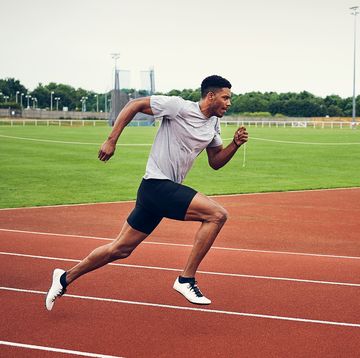I’ve been running for about two years now, and I want to improve my running efficiency. I follow a program that has plenty of variety (tempo, hills, long run, cycling), but I’d love to know what I can do to improve.
Training for speed via intervals, tempo, and other workouts is a great way to improve your overall fitness and performance, and once you add the following elements to your regimen, you’ll gain the ability to run faster while using less energy - and that’s the secret!
Published: 18 August 2016.
1/ Get strong
It’s not uncommon for runners to acquire muscle imbalances that create more work for the body when we ask it to run or move (inefficiency). In fact, even runners that strength-train regularly can fall victim to muscle weakness if they’re not addressing the imbalances directly.
For example, prolonged sitting can cause the glute medius on both sides to weaken or shut off, causing instability and lateral shifting in the hips. This weakness hinders your running form via wasted lateral movement and can also cause overuse injuries like IT band syndrome and other issues down the chain.
The key is to not only include the typical functional multi-joint exercises for runners (squats, lunges), but to also include the more simple exercises (like the clam) that might not seem like they’re doing much but are helping you activate and strengthen a weak, inactive muscle. Here is a list of exercises that will help balance your body strength and better stabilise to run more efficiently with less wear and tear.
- Planks (standard, mountain climbers, side plank raises)
- Squats (single and double leg)
- Lunges
- Clams
- Push ups
- Row with resistance tube or weight
- Glute bridge (with both feet on the ground or single leg)
2/ Resting heart rate
Adding plyometrics into your regular routine will boost strength and speed by improving the elasticity of the muscle via the stretch-shortening cycle. That is, when the muscle is stretched before an explosive contraction, like bending through the knee before a single leg jump, it contracts more powerfully and quickly.
Because these exercises are explosive in nature, it is best to weave them into your programme after you have established a solid base of strength-training, once per week, and in rotation with your strength-training programme. Perform these exercises after your runs to focus on good form, as performing plyometrics with sloppy form can quickly lead to injury. Here are three plyometric exercises for runners. By the way, plyometrics are a little like child’s play once you get the hang of it.
Power skips: Keeping your arms in running form, skip for a total of 20 on each leg, focusing on landing lightly on the balls of your feet and increasing the height of each skip.
Leg bounding: With an exaggerated running form, bound forward by jumping with each stride, focusing on an exaggerated knee lift for 20 seconds. Walk back to recover and repeat 2-3 times.
Squat jumps: Stand with your feet shoulder-width apart and bend into squat position with your hips back and knees bent. Tap the floor with your hands and jump up reaching your hands to straight over your head. Bend your knees as you land, touch the ground again, and repeat for 20 seconds.
3/ Row with resistance tube or weight
Your stride rate is simply the number of steps you take in a minute. To find it, count the number of strides on one foot for one minute and double it. The goal is to have a stride rate of around 180, or 90 per foot. If it’s much less (170) than that, it likely means you’re creating more vertical energy (oscillation), projecting more upward motion than forward, and you guessed it, wasting energy. It also means you’re employing braking forces with every stride rather than rolling quickly over the ground. The key is to practice patience while increasing your stride rate and decreasing the time you spend on the ground.
To improve your stride rate, you can run to a music mix at 180 bpm, invest in a metronome or add the following drill to the beginning or end of your runs (it makes a great active warm-up). Although this drill (and running with a faster cadence) may feel awkward at first, that just means you’re creating new neuromuscular patterns that will soon start to feel more natural. It’s important to note that when running to music or a metronome, it’s best to focus on taking shorter strides and increasing the cadence gradually. If your stride rate is 170, for example, you could set it to 174 and progress slowly from there.
Striders: On a flat straight surface, start running with short, quick strides. Gradually increase the length of your stride while maintaining quick turnover for 30 seconds. Slow down gradually, walk back to the start, and repeat a total of four to six times.
It’s important to remember that Rome wasn’t built in a day, and optimal running efficiency isn’t, either. The good news is a little time invested with these exercises can make a significant difference in your running performance down the road.













